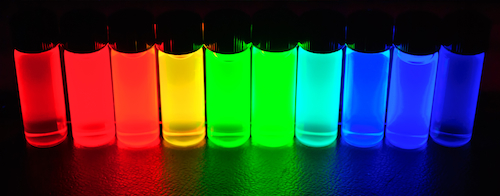
Earthworms make quantum dots!
The synthesis and application of quantum dots, nano-crystalline semiconductor materials, have recently attracted huge interest. Industry uses cadmium-based quantum dots in products including dyes, LEDs, solar cells, and biological-imaging compounds.
Unlike QDs produced via standard laboratory techniques, biosynthesized versions are hydrophilic and compatible with biological systems, making them superior for bio-imaging. However, nature imposes limits on biosynthesis. Specifically, to maximize the production of QDs, organisms must endure high doses of toxic cadmium, which reduces both survivorship and fertility. We solve this problem by imposing natural selection for cadmium resistance on earthworms. Past research in our laboratories demonstrates that such selection results in increased uptake and sequestration of cadmium in metal-rich granules within earthworm tissue.
We’ve designed Eisenia fetida earthworms, selected by cadmium exposure, to thrive in cadmium-spiked soil and to accumulate large amounts of cadmium in their tissue. We hypothesize that the high concentrations of sequestered cadmium will allow the worms to biosynthesize both cadmium telluride and cadmium selenide in high quantities. We also hypothesize that by varying the length of time that the worms live in appropriately spiked soil, we can create QDs in their full color spectrums.
Working with BNL, we’re comparing the CdTe and CdSe quantum dot production of wildtype worms to those of cadmium-accumulating earthworms, and we’re comparing the production of CdTe and CdSe quantum dots in cadmium-accumulating earthworms living in tellurium/cadmium and selenium/cadmium-spiked soil at regular time intervals using a combination of X-ray and electron imaging techniques.